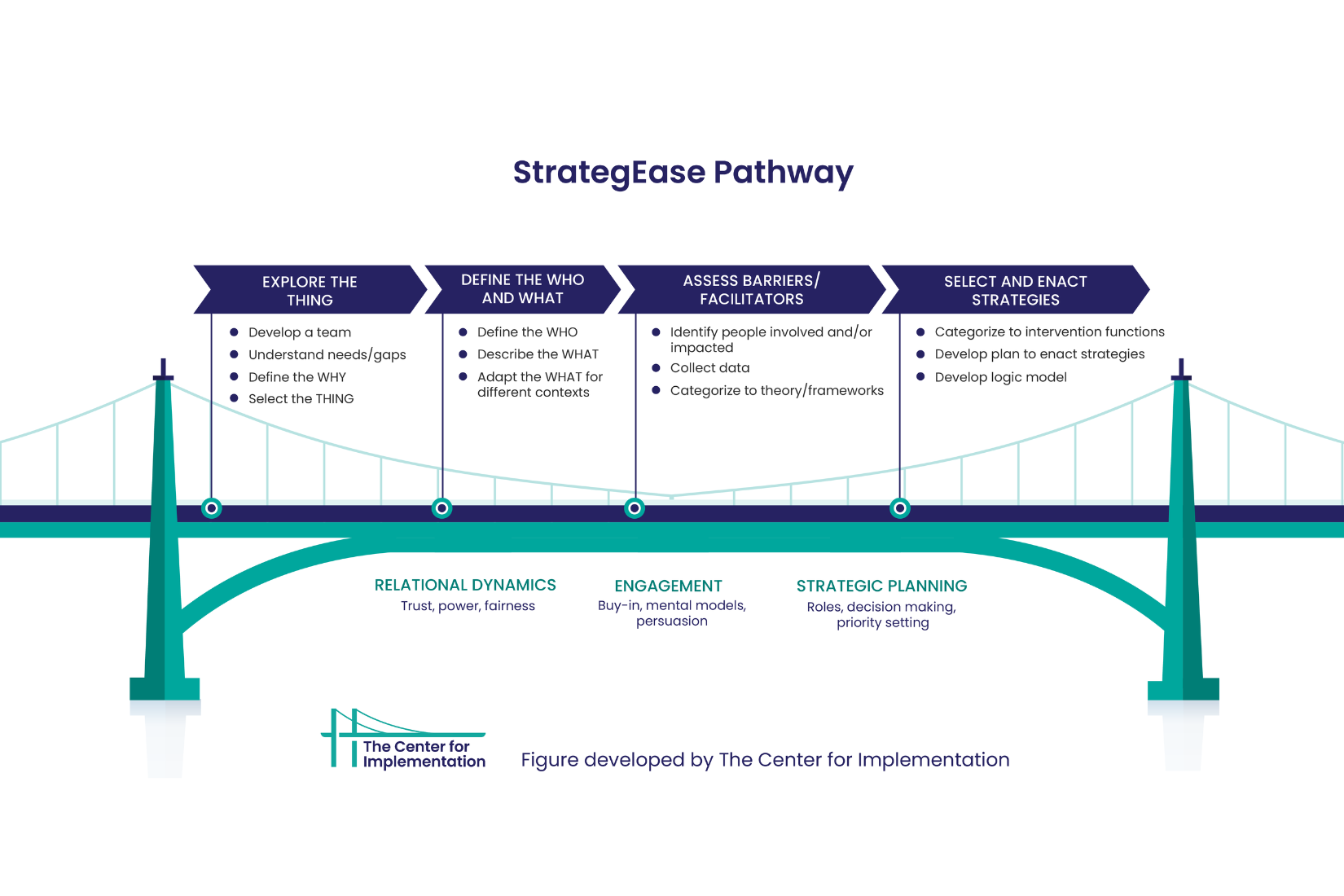The StrategEase Pathway: A Roadmap for Designing Initiatives for Implementation
By Dr. Julia E. Moore, Executive Director, and Dr. Sobia Khan, Director of Implementation
Note: We have updated our website since this article was published. As a result, you may have been redirected here from a previous URL. If you are looking for the article, "Project Spotlight: Better together: integrating taxonomies to describe implementation strategies” by Sheena McHugh, Justin Presseau, Courtney Luecking, and Byron J. Powell, please click here.
At The Center for Implementation, we believe that implementation work is guided by three different pathways, which we refer to as the 1. StrategEase Pathway, 2. Implementation, and Scale Pathway, and 3. the Relational Pathway. Here, we will focus on the StrategEase Pathway and describe our other two pathways in future bulletins.
The StrategEase Pathway is conceptualized as a bridge from evidence to practice that helps to guide people through the process of defining their initiatives. The pathway includes both technical components and relational components. Along the top of the StrategEase bridge are different milestones that represent technical activities involved with defining what you want people to do differently, understanding their barriers and facilitators, and selecting implementation or change strategies to support them to change. Initiatives are then made up of WHAT you want people to do differently and HOW you will support them to change their behavior. For more information on the WHAT and the HOW, check out this post.
The importance of relationships in implementation research and practice
Underneath the StrategEase bridge are relational aspects to this process, like cultivating trust, addressing power dynamics, considering fairness, building shared mental models, persuading people, mapping out roles, sharing decision-making, and priority setting. These elements are not add-ons or additional components; rather, they are the foundation on which all of the other activities lie.
Trends in operationalizing the StrategEase Pathway
We have been working on and refining the StrategEase Pathway for years to build on a growing body of implementation science literature. In the process of training and supporting hundreds of implementation practitioners and researchers around the world, we have noticed trends in people’s experience of going through this pathway as its components encompass the curriculum of Designing for Implementation, one of our signature online courses. Below are a few of our observations.
Exploring the “thing” often feels like a lot of work, but it is a process that is deeply grounded in evidence and requires a skill set that is relatively straightforward to find (not easy, but compared to some of the other implementation activities, there are more individuals with experience and expertise in critically appraising evidence).
People often rush through defining the WHAT and the WHO – in other words, WHO needs to do WHAT differently in order to implement the “thing”. Many assume that they already have a good understanding of this aspect of implementation. This is a stage of the pathway that people most often go back and revisit after realizing they have not defined all of the people who need to change (i.e., all of the WHOs). They also realize they may not have clearly defined what it is they want people to do differently (i.e., the WHAT) or what success looks like.
When people reach the barriers and facilitators stage, they sometimes feel overwhelmed at first, and then a sense of reassurance, as this stage is the most structured. There are frameworks, tools, and measures to assess and understand barriers and facilitators.
Following this, people reach the stage where they select and enact strategies. For years, we have heard people refer to the act of selecting strategies to address barriers and facilitators as “falling off the cliff” or the place “where science meets art”. This is regularly seen as the more challenging part of the StrategEase process.
Why is it challenging to select implementation strategies?
There are multiple reasons why selecting implementation strategies is difficult. Here are just a few of the most common ones we hear:
The list of implementation strategies is really long
Some of the strategies are so broad that it’s hard to envision them
It’s difficult to find evidence of effectiveness for strategies, especially strategies targeting specific types of barriers
Individual, organizational, and system-level strategies are often grouped together
There isn’t an algorithm linking barriers/facilitators and implementation strategies, meaning we need to guess
This article was featured in our monthly Implementation in Action bulletin! Want to receive our next issue? Subscribe here.

